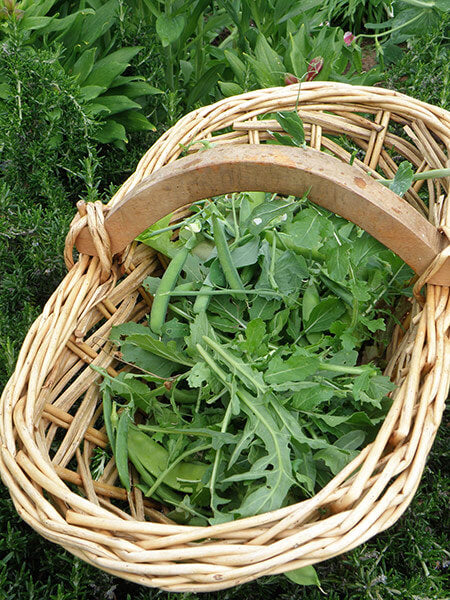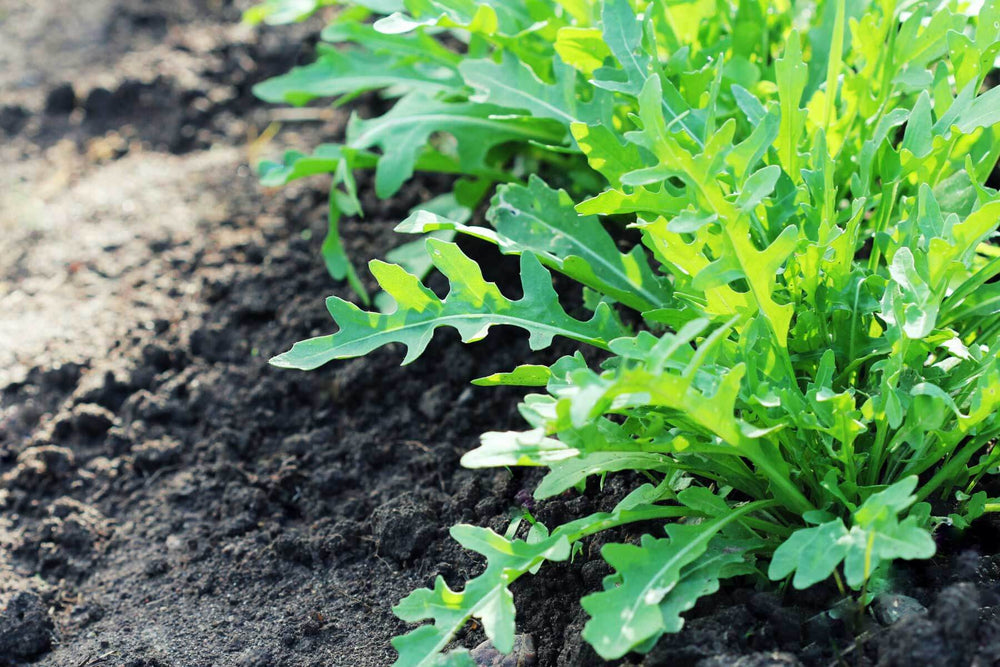Long popular in France and Italy, the leaves of arugula provide a spicy zap when added to a salad. This is the same plant sold in cellophane bags in the grocery store and usually labelled ‘baby arugula.' However, we think that by growing arugula yourself, you'll experience much more (and better) flavour. You decide! You can also saute or steam the leaves like spinach or other leafy greens. Plants look a little like dandelions, but are bigger and more open. Leaves grow best in cool weather. Leafy plants grow 6 to 12 inches tall while in the harvest stage.
Quick Guide to Growing Arugula
- Grow arugula during the cool days of early spring or fall. It grows well in raised beds, containers, and in-ground gardens.
- Plant arugula 12-18 inches apart in a sunny location with fertile, well-drained soil.
- Before planting, mix compost or other rich organic matter into your native soil to improve nutrition and texture.
- Water in gently and keep soil consistently moist throughout the growing season by watering when the top inch of soil becomes dry.
- Encourage excellent leaf production by regularly feeding with a continuous-release plant food.
- Preserve soil moisture and prevent weeds with a layer of organic material such as dried pine needles or dry grass clippings.
- Harvest the outermost leaves once they are large enough to eat.
- Flowering will begin as summer approaches, changing the flavor. Pull the plant when the flavor becomes too intense.
Soil, Planting, and Care
Arugula (Eruca vesicaria) is a green with zip. Sometimes called rocket or roquette, arugula should be planted in the garden in early spring or fall. It will grow in a rosette about a foot wide and equally tall, if you let it. Like leaf lettuce, mustard greens, and collards, arugula stretches skyward in hot weather, blooming and setting seeds. You can pull it up when plant start to send up a bloom stalk from the center, or you can continue harvesting the leaves until they taste too strong. Some gardeners cut the plants back to get another harvest as it tries to grow back. The bloom stalks may grow 24 to 36 inches tall and have little white flowers on top. These are edible and look pretty in a salad. Flowering signals that the season is ending for arugula and you can replace it with a warm weather crop, unless you want to try cutting it back and eating it just a little longer.
Here's the trick to getting to harvest time faster: Skip the seeds and plant Bonnie Plants® arugula instead. With that kind of head-start, these strong, vigorous young plants may even be big enough to pick just 10 days after you put them in your garden.
Arugula grows fast. Set plants in the sunny garden in early spring for spring harvest or late summer for fall harvest. Plants prefer the cooler days of spring or fall. Like any leafy green, arugula requires a rich soil to make its best growth, and it will grow even better if you feed it with top-quality plant food, too. Before planting, improve your native soil by mixing in aged compost-enriched Miracle-Gro® Performance Organics® All Purpose In-Ground Soil or straight compost . If you're planting in pots, fill them with Miracle-Gro® Performance Organics® Container Mix to give roots an excellent growing environment. Then give arugula regular feedings with Miracle-Gro® Performance Organics® Edibles Plant Nutrition, which instantly delivers nutrition to both your plants and the beneficial microbes in the soil. (Be sure to follow the directions on the label.) Space plants 12 to 18 inches apart.
Troubleshooting
When flowering begins in late spring or early summer, the flavour becomes more intense. At some point it may be stronger than you like, which means its time to take it out and wait for the next cool season to plant (early spring or fall).
Harvest and Storage
Pick only the outer leaves, so the plant remains intact and usable for weeks to come. This cut-and-come again harvest keeps the plant yielding lots of leaves until the plants flower. Harvest often to encourage new growth.
Uses
Arugula is considered a vegetable when it is cooked and eaten like spinach, or it can be used more sparingly as an herb to flavor a salad, meat, or pasta sauce. It is not for those who prefer mild flavour like that of an Iceberg lettuce salad; it calls for an adventurous palate. Try the leaves in some of our arugula recipes. Add arugula flowers to salads in late spring or summer as the plants grow a tall bloom. At this point the leaves may be more pungent than you like, but try them just in case.




FAQs
When is the best time to plant arugula?
Arugula is a cool-season annual, meaning that it is good in spring or fall. Plant in full sun and fertile, well-drained soil. Like any herb or vegetable that needs to grow green leaves, arugula will benefit from compost and/or fertilizer. Water when the soil gets dry. Then all you need to do is enjoy its distinctive, seasonal flavor.
Do you have any suggestions for harvesting and using arugula?
Harvest the outer leaves while the plant is still growing in a tight rosette close to the ground. Blend them with mild-flavored lettuces. Once arugula begins to bloom, the flavor can grow stronger. That's when you need to add other greens and fresh herbs such as dill, basil, and thyme to flavor your salads. Introduce newcomers to tender leaves picked from young plants.
How do I keep the flavor of arugula from growing so strong?
Young arugula tastes milder, and larger, more mature arugula tastes stronger. There are two ways to approach your problem. First, you can plant arugula every couple of weeks to ensure a continuous supply of mild but flavorful young leaves. On the other hand, you can harvest more leaves, so the plant needs to continually replace the old with new. Either way, you will need to replant periodically. Remember, arugula is like lettuce. It flowers in hot weather, so unless you live where the summer is cool, you will only have homegrown arugula in spring and fall.




 Herbs
Herbs
 Vegetables
Vegetables
 Fruit
Fruit
 Flowers
Flowers
 Succulents
Succulents


